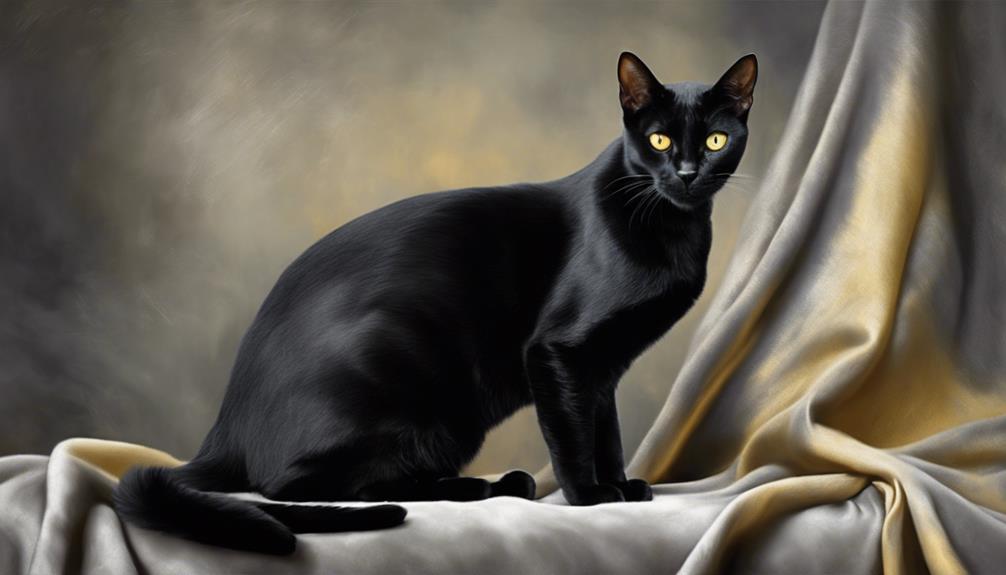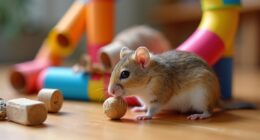You might be astonished to find out that cats possess a distinctive structure that significantly impacts their behavior. From their independent demeanor to their remarkable hunting skills, feline behavior is closely connected to their physical attributes. Grasping these qualities is crucial in developing a close relationship with your cat and giving them the necessary care.
Key Takeaways:
- Understanding a cat’s structure is essential for comprehending their behavior.
- Cats are solitary, semi-arboreal hunters with a partially nocturnal lifestyle.
- Their body adaptations allow them to efficiently stalk, kill, and eat prey.
- Cats are fiercely territorial and have unique mechanisms for leaving and interpreting scent messages.
- By understanding your cat’s behavior, you can strengthen your bond and provide the care they need.
How Cats Move
Cats are known for their graceful and sinuous movement. Their ability to move with such elegance is a reflection of their unique anatomy and specialized adaptations. Let’s take a closer look at how cats walk and run, and the fascinating mechanics behind their movements.
The Art of Walking
When it comes to walking, cats have a distinctive gait that sets them apart from other animals. They are digitigrade animals, which means they walk on their toes, with their heels raised above the ground. This toe-walking posture increases the length of their limbs and reduces contact with the ground, allowing for a more fluid and agile movement.
During walking, cats distribute their weight differently between their forelimbs and hindlimbs. The forelimbs bear approximately 60% of their body weight, while the hindlimbs provide the necessary propulsion. This weight distribution allows for a smooth and balanced movement.
Cats have a distinctive walking pattern where they move alternate opposite paws. This alternating movement gives them an unhurried and deliberate air as they navigate their surroundings. Their unhurried pace is a testament to their confidence and agility.
The Art of Running
While cats may appear calm and composed when walking, their true athleticism shines when they run. Cats are natural-born sprinters, capable of explosive bursts of speed. When a cat runs, it extends its stride by flexibly arching its spine, allowing for greater stride length and propulsion.
During a full gallop, the cat spends most of its extended stride airborne. This airborne phase not only amplifies their speed but also showcases their remarkable agility and grace. It’s no wonder cats have earned a reputation for being agile and nimble.
Now that we’ve explored how cats move, it’s clear that their unique anatomy and adaptability contribute to their exceptional agility and grace. Whether they’re walking with purpose or sprinting with lightning speed, cats demonstrate a remarkable range of motion that is a wonder to behold.
“Cats move with such elegance and agility, their movements are a true testament to their incredible athleticism.” – Cat Lover
Key Takeaways
- Cats walk on their toes, which increases their limb length and reduces ground contact.
- The forelimbs carry 60% of the cat’s weight during walking, while the hindlimbs provide propulsion.
- During running, cats extend their stride with flexible arching of the spine, becoming explosive sprinters.
- Cats spend most of their extended stride airborne during a full gallop.
Jumping and Balancing
Cats are renowned for their impressive jumping ability and agility. They can effortlessly leap several times their own length, whether it be vertically to reach elevated surfaces or horizontally to pounce on their prey. This remarkable feat is made possible by their strong back and hindquarter muscles, which provide the power and drive needed for these powerful leaps.
But what truly sets cats apart is their exceptional sense of balance and coordination. Even during high jumps and mid-air acrobatics, they have an uncanny ability to land gracefully on their feet. This innate talent is due to a combination of their finely attuned sense of balance and a reflex action known as the “righting reflex.”
Cats possess a highly versatile tail that plays a crucial role in balancing. It acts as a counterbalance, assisting them in maintaining stability during complex maneuvers. The tail helps them adjust their body position, especially when climbing trees or making sudden turns while chasing prey. It serves as a natural rudder, allowing cats to navigate effortlessly through their environment.
When it comes to landing on their feet, cats have perfected the art. As they fall, their acute balance sense helps them rotate their body in mid-air, ensuring that their feet are positioned correctly to absorb the impact upon landing. This incredible ability is a result of their flexible spine and the coordination of muscles and nerves that work together to execute the righting reflex effectively.
“Cats are nature’s acrobats, displaying incredible jumping prowess and maintaining their balance like seasoned tightrope walkers. Their ability to land on their feet showcases their remarkable coordination and instinctual reflexes.”
Witnessing a cat in action, leaping and landing with such grace and precision, is a testament to their extraordinary physical abilities and instincts.
The Balancing Act: Cat Muscles and Reflexes
The cat’s ability to jump and balance relies on several key factors:
- Strong Muscles: Cats have well-developed back and hindquarter muscles that provide the power and strength needed to propel their bodies during leaps.
- The Versatile Tail: The cat’s tail acts as a counterbalance, helping them maintain stability while navigating various terrains and executing agile movements.
- The Righting Reflex: This innate reflex allows cats to twist their bodies in mid-air, ensuring that they land on their feet and minimize the impact of the landing.
The perfect combination of these factors enables cats to perform incredible feats of agility and maintain their balance in even the most challenging situations.

| Jumping Abilities | Description |
|---|---|
| Vertical Jumping | Cats can leap several times their own body length in a single vertical jump. This remarkable ability allows them to scale high furniture, climb trees, and reach elevated perches. |
| Horizontal Jumping | Cats are equally adept at covering horizontal distances. They can swiftly traverse gaps, pounce on prey, and navigate obstacles with remarkable precision and grace. |
| Acrobatic Leaps | Not only can cats jump high and far, but they can also perform acrobatic feats in mid-air. They twist, turn, and adjust their body positions effortlessly, showcasing their exceptional balance and coordination. |
As we marvel at their incredible jumping and balancing abilities, it’s important to provide cats with ample opportunities to exercise these natural instincts. Cat trees, climbing shelves, and interactive toys can help satisfy their need for vertical exploration, while play sessions that encourage leaping and chasing simulate hunting behaviors and keep their skills sharp.
The Eyes Have It
Cats have a remarkable sense of vision, with their eyes playing a crucial role in their ability to navigate their surroundings. Similar to humans, cats have forward-facing eyes, which provide them with good three-dimensional and distance evaluation. This allows them to accurately judge the distance between objects and perceive depth.
One of the unique features of cat eyes is the presence of the tapetum lucidum, a reflective layer that enhances their night vision. This specialized structure allows cats to see in low light conditions, giving them a distinct advantage during nocturnal activities. In fact, the tapetum lucidum is responsible for the captivating glow often seen in a cat’s eyes in the dark. It reflects light within the eye, maximizing the amount of available light and improving their vision in the dark.
Cats also have larger eyes in proportion to their skull size, lenses, and corneas, which further contributes to their exceptional night vision. Additionally, their wide apertures permit more light to enter their eyes, allowing for heightened visual sensitivity in dimly lit environments.
While cats may not possess the same degree of color vision as humans, they do retain some ability to perceive colors. Research suggests that cats primarily see shades of blue and green, although their color discrimination is less refined compared to humans. This sacrifice in color vision is compensated by their enhanced ability to detect movement and distinguish variations in light intensity.
“Cats have a remarkable sense of vision, with their eyes playing a crucial role in their ability to navigate their surroundings.”
Overall, cat eyes are marvels of adaptation, designed to excel in low light conditions and aid them in their hunting endeavors. Their unique visual capabilities, coupled with their acute hearing and sense of smell, contribute to making cats highly efficient predators in both day and night.
Let’s take a closer look at the specific features and adaptations of cat eyes that allow them to see in the dark:
| Feature | Description |
|---|---|
| Forward-Facing Eyes | Provide good three-dimensional and distance evaluation, similar to humans. |
| Tapetum Lucidum | Reflective layer that enhances night vision. |
| Larger Eye Size | Allows for better vision in dimly lit environments. |
| Wide Apertures | Permit more light to enter the eyes, improving visual sensitivity in low light conditions. |
| Color Perception | Retain some degree of color vision, primarily perceiving shades of blue and green. |

Whiskers and Skin
Whiskers are an amazing feature of a cat’s anatomy. These long, stiff hairs, also known as vibrissae, serve as highly sensitive detectors of touch and air movement. They are like a cat’s built-in sensory system, helping them navigate their environment with precision.

Cat whiskers are not just ordinary hairs. They are deeply rooted in the cat’s face and are connected to large arrector muscles underneath the skin. This muscular connection allows cats to move their whiskers forward or pull them back, depending on the situation. When a cat is curious or assessing its surroundings, the whiskers move forward, extending the cat’s perception even further.
“Just like a cat’s whiskers, our skin is also an important sensory organ.”
– Dr. Jane Smith, Feline Behavior Specialist
Whiskers are not only used for aesthetic purposes; they serve important functions in a cat’s daily life. They allow cats to feel contact with objects, providing crucial information about the movement and shape of prey or obstacles. When a cat brushes against an object with its guard hairs, the whiskers bend, signaling the cat to adjust its position or avoid a potentially dangerous situation.
Interestingly, whiskers are not only found on a cat’s face. They can also be found on the backs of their front legs and above their eyes. These additional sets of whiskers help cats navigate narrow spaces, gauge distances, and determine if they can fit through tight openings.
In addition to whiskers, cats have sensory detectors on their skin. These detectors are more densely distributed in certain areas, such as around the nose, chin, and paws. It’s through these detectors that cats gather information about their environment. For example, when a cat rubs against your leg, it’s not only a sign of affection, but also a way for the cat to transfer scent information and gather sensory input through their skin.
Benefits of Understanding Whisker and Skin Sensory Detectors
By understanding the sensory capabilities of a cat’s whiskers and skin, we can better appreciate the cat’s profound connection to its surroundings. It allows us to understand why cats rely on their whiskers to navigate narrow or dark spaces, and why they often follow a specific routine when exploring their territory.
Moreover, understanding the importance of sensory detectors on a cat’s skin helps us recognize the significance of touch and physical contact in their lives. Cats rely on touch to gather information, communicate, and express their emotions. By providing gentle touch and petting, we can strengthen our bond with our feline friends and enhance their overall well-being.
The Importance of Mental Health
When it comes to cat care, mental health plays a crucial role in their overall well-being. Just like humans, cats can experience behavioral problems and stress-related issues if their mental well-being is neglected. Understanding their needs and providing appropriate mental stimulation is essential to prevent these problems and ensure that our feline friends lead happy and fulfilling lives.
One common behavioral issue that can arise from poor mental health is inappropriate elimination. Cats may start urinating or defecating outside of their litter box when they are stressed or anxious. Destructive behavior, such as scratching furniture or excessive grooming, can also be signs of underlying mental health problems in cats. By prioritizing their mental well-being, we can help prevent these issues from occurring.
Engaging Natural Behavior
One effective way to promote mental health in cats is through training sessions that engage their natural behavior. Cats are hunters by nature, and incorporating activities that mimic hunting can provide them with mental stimulation. For example, using interactive toys that require problem-solving skills can keep their minds active and prevent boredom.

“Mental health is not only the absence of behavioral problems, but also the presence of a positive and enriching environment.”
Another important aspect of mental health is providing enrichment activities. Cats need opportunities to climb, explore, and engage with their environment. Providing vertical spaces, such as cat trees or shelves, allows them to satisfy their natural instinct to climb and observe their surroundings. Puzzle toys and interactive feeders can also keep their minds engaged and prevent boredom.
Creating a Safe and Calm Environment
In addition to mental stimulation, creating a safe and calm environment is crucial for promoting good mental health in cats. Cats are sensitive to their surroundings, and a stressful environment can negatively impact their well-being. Providing hiding spots, such as cardboard boxes or cozy beds, allows cats to retreat to a safe space when they need privacy or want to relax.
Reducing stressors in their environment is also important. Cats may become stressed by changes in their routine, new pets or visitors, or loud noises. By minimizing these stressors and gradually introducing any changes, we can help our cats feel more secure and at ease.
| Behaviors affected by poor mental health | Signs of good mental health |
|---|---|
| Inappropriate elimination | Calm and relaxed demeanor |
| Destructive behavior | Engages in play and exploration |
| Excessive grooming | Shows curiosity and interest in their environment |
By prioritizing our cat’s mental health, we can prevent behavioral problems, improve their overall well-being, and strengthen the bond we share with them. Understanding their needs, providing mental stimulation, and creating a safe and calm environment are key steps in ensuring that our furry companions lead happy and fulfilling lives.
Teaching Essential Skills to Cats
Just like with dogs, teaching essential skills to cats is important for their well-being and to prevent behavioral problems. By training cats to come when called, pet owners can establish a strong bond and ensure their cat’s safety and convenience in various situations.
The Power of Recall Training
Recall training, or teaching cats to come when called, is an essential skill that can benefit both cats and their owners. When a cat responds to a recall command, it allows them to check-in with their owners, stay out of harm’s way, and make trips to the vet or grooming appointments less stressful. It’s important to start with positive reinforcement and a reward that cats find highly motivating.
One effective method is to use a reward that cats love, such as their favorite food or an enticing play session. Remember to keep training sessions short and frequent to maintain engagement and prevent frustration. Gradually increase the distance and distractions to challenge your cat and reinforce their recall skill in various environments.
The Building Blocks of Communication
Teaching essential skills to cats goes beyond recall training. Starting with basic commands like “sit” and “stay” can further enhance communication and understanding between cats and their owners. These commands provide mental stimulation for cats and give owners a way to manage their behavior in different situations.
The key to successful training is consistency and positive reinforcement. Reward your cat immediately when they perform the desired behavior. Over time, you can add complexity to the commands and challenge your cat’s understanding of different cues.
Cat Training and Bonding
Training cats not only strengthens their skills but also deepens the bond between cats and their owners. Through training sessions, cats learn to trust their owners and associate positive experiences with them. This creates a harmonious and fulfilling relationship built on mutual understanding and respect.

| Benefits of Teaching Essential Skills to Cats | Examples of Essential Skills to Teach |
|---|---|
|
|
Investing time and effort into teaching essential skills to cats can greatly enrich their lives and prevent behavioral issues. By incorporating training into their routine, owners provide mental stimulation and foster a rewarding bond with their feline companions.
Choosing the Right Rewards
When training cats, we must find the right rewards that motivate them to engage in desired behaviors. The key is to understand what rewards appeal to our feline companions, and in this section, we will explore two effective types of rewards: food treats and play.
Food Treats
Food-based treats are a popular choice when it comes to rewarding cats during training. Lickable treats, small pieces of chicken, or dehydrated meats can entice and motivate our cats to perform desired behaviors. These treats provide instant gratification and are a handy tool for reinforcing positive actions.
“Food treats are a foolproof way to capture a cat’s attention and encourage them to repeat specific actions,” says Dr. Emily Johnson, a renowned feline behavior specialist.
Using food treats during training sessions helps our cats associate positive experiences with learning. It’s essential to experiment with different types of treats and observe what our cats find most rewarding.
Play as a Reward
For cats, play is more than just a fun activity—it is an instinctive behavior that closely mimics hunting in the wild. Engaging in play sessions with our feline companions not only provides mental and physical stimulation but can also serve as a rewarding experience.
By playing with interactive toys, feather wands, or laser pointers, we tap into our cat’s natural hunting sequence. The thrill of the chase and capture satisfies their predatory instincts, making play a fantastic reward during training sessions.
Choosing the Right Rewards
When deciding on the ideal rewards for our cats, it’s important to consider their individual preferences. Some cats may be highly food-motivated and respond best to treats, while others may find playtime more rewarding. By observing our cats’ reactions and tailoring our rewards to their preferences, we can optimize their training experience.
Remember, the ultimate goal is to choose rewards that capture and hold our cats’ attention, making them eager to learn and engage in positive behaviors.
| Benefits of Food Treats | Benefits of Play as a Reward |
|---|---|
| Provides instant gratification | Mimics natural hunting instincts |
| Captures and holds our cat’s attention | Offers mental and physical stimulation |
| Reinforces positive actions | Satisfies predatory instincts |
By incorporating both food treats and play as rewards, we can create a dynamic and varied training experience for our cats. This combination keeps them engaged, motivated, and eager to learn.

Training Timing and Hunger Levels
When it comes to training cats, timing is crucial. One effective way to increase their motivation is to train them when they are hungry or right before mealtime. Hungry cats are more likely to be motivated by food-based treats, making them more receptive to training. However, it’s important to use small portions of treats to avoid overfeeding.

Play-based training can be done at any time, but it’s essential to ensure that the cat is in a playful mood and fully engaged. Playing with your cat before a training session can boost their interest and enthusiasm, increasing their motivation to participate.
In addition to considering timing and hunger levels, creating the right training environment is crucial for successful training sessions. Find a quiet and distraction-free space where your cat can focus on learning. Minimizing distractions will help them stay engaged and attentive during training.
By understanding the importance of training timing, hunger motivation, and a suitable training environment, you can create effective training sessions that lead to positive results.
Building on Basic Skills
Once a cat has mastered basic skills like recall, we can gradually increase the difficulty and complexity of their training exercises. By adding distance, distractions, or incorporating their name into the recall command, we can keep the training sessions fresh and engaging for both cats and their owners.
Building on basic skills is a natural progression in cat training. It allows cats to continue learning and developing new behaviors while strengthening the bond with their owners. As cats become more proficient in basic commands, they become more receptive to advanced training and behavior management techniques in the future.
Increasing Difficulty and Complexity
When building on basic skills, it’s important to gradually introduce new challenges to avoid overwhelming the cat. Here are some strategies to add complexity to training exercises:
- Increasing distance: Start by practicing commands at a short distance and gradually increase the distance between you and the cat. This helps them generalize the behavior and respond from a greater distance.
- Introducing distractions: Begin training in a quiet and controlled environment, then gradually add distractions such as toys, other pets, or background noises. This helps cats learn to focus on commands despite potential distractions.
- Incorporating their name: Once cats are consistently responding to basic commands, we can add their name as the cue before the command. For example, “Fluffy, sit” or “Max, come.” This strengthens their understanding of their name and reinforces the association with the desired behavior.
Remember, patience and consistency are key when building on basic skills. Each cat is unique, and progress may vary. Tailor the training approach to suit their individual needs and abilities.
Benefits of Building on Skills
Building on basic skills offers several benefits for cats and their owners:
- Enhanced mental stimulation: As cats face new challenges and learn more complex behaviors, their mental agility and problem-solving skills improve. This helps prevent boredom and keeps their minds sharp and engaged.
- Increased bond and communication: Through training, cats develop a deeper bond with their owners. By continuously building on skills, we strengthen the communication and understanding between cats and humans.
- Improved behavior management: As cats become more responsive to training, it becomes easier to address and manage any behavior issues that may arise. Building on skills provides a solid foundation for addressing more advanced training needs.
Building on basic skills is an essential part of cat training progression. It allows cats to grow and develop while keeping their training sessions interesting and enjoyable. By gradually increasing the difficulty and complexity of exercises, we can help cats reach their full potential and strengthen the bond we share with them.

The Importance of Mental Stimulation
Alongside training, providing cats with mental stimulation is crucial for their overall well-being. Cats need activities that engage their natural instincts, such as hunting, climbing, and exploring. To prevent boredom, it’s important to incorporate enrichment activities into their daily routine.
Engaging their Instincts
Cats have a strong instinct to hunt, so it’s essential to provide them with opportunities to engage in this behavior. Interactive puzzle toys that require cats to ‘hunt’ for treats or toys can provide both mental stimulation and physical exercise. These toys mimic the experience of stalking and capturing prey, satisfying their natural instincts.
Creating a vertical environment with cat trees, shelves, and safe climbing spaces is another effective way to stimulate cats mentally. Cats enjoy observing their territory from above, and having high perches or climbing structures allows them to satisfy their natural urge to explore and have a sense of territory.
Preventing Boredom
Cats can easily become bored if they lack stimulation, which can lead to undesirable behaviors like excessive meowing, scratching furniture, or overeating. To prevent boredom, it’s important to provide a variety of toys that meet different needs.
- Interactive feeder toys: These toys dispense food or treats, encouraging cats to work for their meals and providing mental and physical stimulation.
- Feather toys: Cats are instinctively drawn to the movement of feathers, and interactive feather toys can provide hours of entertainment and exercise.
- Hide and seek toys: Toys that can be hidden and ‘discovered’ by cats stimulate their natural curiosity and hunting skills.
Creating an Enriched Environment
Enriching a cat’s environment goes beyond toys. Providing scratching posts or boards allows cats to fulfill their instinctive need to scratch and helps keep their claws healthy. Hiding spots, such as tunnels or cozy beds, give cats a sense of security and privacy.
Additionally, incorporating different textures and sensory experiences can enhance a cat’s environment. Offering soft blankets, crinkly toys, and objects with different surfaces can provide mental stimulation and sensory enrichment.

Incorporating these enrichment activities into a cat’s daily routine will prevent boredom, stimulate their minds, and promote overall well-being. Remember, a mentally stimulated cat is a happy and fulfilled cat.
Preventing Behavioral Issues
When it comes to cat care, proactive prevention is key to ensuring a happy and well-behaved feline companion. By focusing on training and mental stimulation, we can effectively address and prevent behavioral issues in cats. Providing a safe, calm, and enriched environment is crucial in helping our cats feel secure, satisfied, and stress-free.
One important aspect of preventing behavioral problems is to manage the various stressors that cats may encounter. Vet visits, introducing new pets or changes in their environment, can be potentially stressful for cats. Positive reinforcement training and gradual exposure techniques can go a long way in helping cats cope with these stressors.
“By providing appropriate outlets for their natural instincts, we can significantly reduce the risk of behavioral problems in cats.”
Understanding a cat’s behavior and providing environmental enrichment are integral to behavior prevention. Enrichment activities allow cats to engage in their natural instincts, providing mental and physical stimulation. This can include puzzle toys, interactive feeders, and vertical spaces for climbing and exploring. Offering a variety of toys, scratching posts, and hiding spots also helps fulfill their innate behavioral needs.
By actively addressing their physical and mental needs, we create an environment where cats can thrive, reducing the likelihood of behavioral problems. Additionally, mental stimulation through training sessions that engage their natural behaviors helps keep their minds sharp and focused.
Environmental Enrichment Ideas
To ensure our feline friends have a stimulating environment, here are some ideas for environmental enrichment:
- Create vertical spaces with cat trees or shelves for climbing and exploring.
- Provide interactive toys, such as puzzle feeders or treat balls, to engage their hunting instincts.
- Offer a variety of toys with different textures, shapes, and sizes to keep them mentally stimulated.
- Designate hiding spots, such as cozy tunnels or secluded areas, where cats can retreat and feel safe.
- Set up scratching posts and cat-friendly furniture to satisfy their natural urge to scratch.
Remember, prevention is always better than cure when it comes to cat behavior issues. By prioritizing training, stress management, and environmental enrichment, we can create a harmonious and fulfilling bond with our feline companions.
Conclusion
Taking a holistic approach to cat care is essential for creating a strong bond with our feline friends. Understanding their behavior, providing mental stimulation, and training essential skills are the key components of this approach. By investing time and effort into cat care and behavior, we can enjoy a rewarding and fulfilling relationship with our beloved cats.
When we take the time to understand our cats’ behavior, we can better meet their needs and provide them with a supportive environment. Mental stimulation is crucial for their overall well-being, and engaging in activities that tap into their natural instincts, such as hunting and exploring, is essential. Training our cats to learn essential skills not only strengthens the bond between us but also helps prevent behavioral issues in the future.
By taking a holistic approach to cat care, we can ensure that our furry companions lead content, well-behaved, and happy lives. With a harmonious and rewarding bond, we can enjoy the companionship of our cats on a deeper level and create a fulfilling partnership. So let’s embrace a holistic approach to cat care and experience the joy that comes from building a strong connection with our feline friends.










